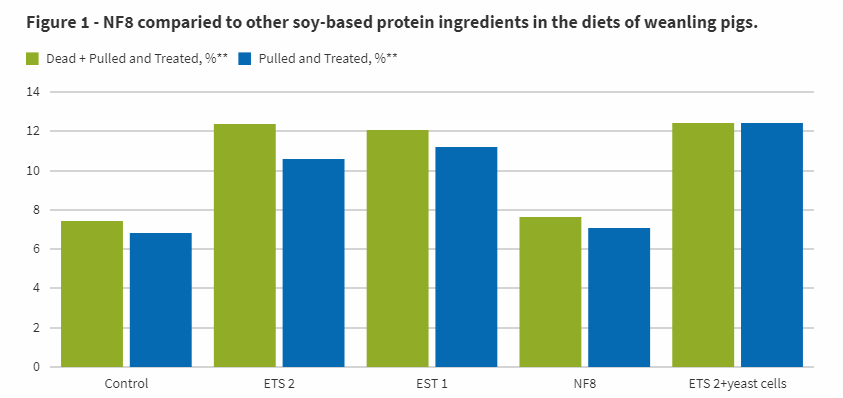Introduction:
The Biotech Company (Nutraferma) uses two strains of bacteria to create a soy protein component with a probiotic that helps to balance beneficial bacteria in the piglet gut. Solid-state fermentation with lactic acid bacteria reduced most soybean anti-nutritional factors and degraded long-chain peptides for better absorption in the small intestine of piglets.
The translation summary in the allaboutfeed.net magazine compiled by Nutraferma (2018) titled “The perfect probiotic for pigs” is about the source of soybean meal that is commonly used in animal diets, but its use in Piglets are hindered by anti-nutritional factors, oligosaccharides and trypsin inhibitors that interfere with the absorption of many nutrients by the small intestine.
In addition, piglets are prone to many gastrointestinal infections because their stomachs do not produce as much hydrochloric acid as adults. This high pH environment can cause the overgrowth of pathogenic bacteria and hinder populations of beneficial bacteria needed for healthy digestion. It also leads to more undigested food going to the lower part of the digestive tract.
To overcome the aforementioned shortcomings in pig nutrition, Nutraferma has produced soybean meal fermented with probiotic strains to yield a more beneficial probiotic soybean protein compared to conventional soybean meal. . The summary of the article is presented in the following sections.
Addressing microbial imbalances
At the same time, microbial imbalances and limited food breakdown result in inadequate uptake of nutrients in young animals. To address this problem, Nutraferma developed a product called NF8, a fermented soy protein ingredient in live fermentation cultures; contains beneficial lactic acid and for better digestibility. It functions on par with animal proteins commonly used in livestock.
The recognized strains of bacteria Bacillus subtilis and Pediococcus pentosaceus convert soybean meal into more efficient and digestible proteins by:
* Producing lactic acid, so nutrients in food have more bioavailability.
* Helps to create a balance of beneficial bacteria in the gut of young animals and food will be more resistant to pathogens.
* Lower anti-nutritional factors. Trypsin inhibitors are reduced in potency and oligosaccharides are reduced to almost undetectable levels.
* Increased solubility protein levels by 19.5% compared with 10-12% seen in unfermented soybean meal.

Probiotic soy digestive health
In terms of digestibility and protein intake, this product is on par with protein of animal origin, like fishmeal, but has the benefit of being probiotics. To create NF8, Nutraferma inoculated Bacillus subtilis and Pediococcus pentosaceus in soybean meal and fermented it under controlled conditions of humidity, pH, temperature and oxygen levels. This process is called aerobic solid-state fermentation (MASS), natural and enzyme-producing processes that make soybean meal more digestible and nutritious.
This bacterium continued to provide benefits, even after complete transformation to NF8. Unlike many other lactic acid-producing bacteria used in animal feed, this recognized heat-resistant strain of Pediococcus pentosaceus can survive at the high heat levels involved in pelleting. In a laboratory test, 98% of Pediococcus pentosaceus bacteria survived in pelleting. This means that the bacteria can enter the animal’s digestive system to improve bacteria’s balance.
Lactic acid for microbial balance and nutrient absorption
Another advantage of the recognized strain of Pediococcus pentosaceus is that it produces lactic acid. This lowers the pH of the final product, reducing the acidifier needed in the pelleted feed. Lactic acid may also provide young animals with access to the nutrients in their feed by lowering pH in the digestive tract.
This helps prevent undesirable bacteria from entering the digestive tract and encourages the growth of beneficial bacteria. Therefore, NF8 promotes healthy bacterial balance in 2 ways:
1.Creating the right gut environment promotes the growth of beneficial bacteria. 2.Creating a healthy microbial balance can help young animals get more nutrients from their diets, increasing health and growth.
Research-proven alternative protein source
A 47-day guided study using analytical methods in predominantly pigs compared NF8 with other soy protein components in the diets of newly weaned pigs. The purpose of the experiment is to evaluate the effects of these components on growth performance and pig health status.
NF8 was compared with 2 enzyme-treated soy products (ETS), ETS1 andthe ETS2, along with a positive control containing fishmeal and EST2 + yeast cells. These diets were reared in four stages with diets consisting of a lysine base with synthetic amino acids used for equilibrium in the test diets. Feed-grade antibiotics were also included in the diets starting day 3 after experimental setup.
In addition, all pigs are vaccinated to prevent Reproductive and Respiratory Syndrome (PRRS) and Swine Pneumonia (Mycoplasma hyopneumoniae). The diet treatments were:
Treatment 1: Control
Treatment 2: Including 8% EST2 in the diet
Treatment 3: Including 8% EST1 in the diet
Treatment 4: Consisting of 9% NF8 in the diet
Treatment 5: Including EST2 + yeast cells, corresponds to 8% and 0.10% respectively

Pig weight and feed consumption were calculated as average daily gain, feed efficiency (feed/weight gain) and average daily intake. Health data are collected, eg mortality, swine removed and treated. The results of the trial shown in Figure 1 only showed that pigs fed NF8 had significantly lower mortality and drug treatment withdrawal, with comparable growth performance compared to other soy products.
Reviews and applications
It is clear that the beneficial bacteria Bacillus subtilis and Pediococcus pentosaceus are capable of solid fermentation on soybean meal, reducing the effect of anti-nutrients, lactic acid production, especially turning soy protein into digestible protein and balancing the flora gut…. Swine farmers using diets containing high protein ingredients from soybean meal can use Vemedim products containing ingredients of Bacillus subtilis and Pediococcus acidilactici. One of the products that are being used by many swine farmers is probiotics. It is also possible to combine PROBiP with Vime-Subtyl in the diet of weaned piglets to help balance the intestinal microflora, improve digestibility and prevent diseases caused by E. coli. Details of the product’s ingredients and usage are specified on the packaging of each product.
REFERENCE
Nutraferma (2018) The perfect probiotic for pigs.


